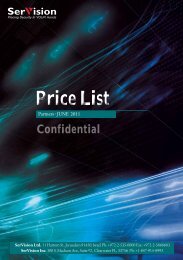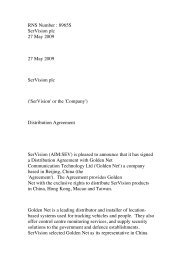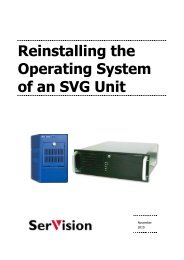TVG-Series System Guide v1-4 - SerVision
TVG-Series System Guide v1-4 - SerVision
TVG-Series System Guide v1-4 - SerVision
You also want an ePaper? Increase the reach of your titles
YUMPU automatically turns print PDFs into web optimized ePapers that Google loves.
<strong>SerVision</strong><br />
<strong>TVG</strong> <strong>System</strong> <strong>Guide</strong><br />
To solve these two problems, VMD event detection can be configured to control the length of events using the<br />
following parameters:<br />
• Debounce: The interval between the end of motion as detected by the unit and the time when the event is<br />
defined as ending<br />
• Maximum length: The maximum length of a single event<br />
Separate events are defined when motion is not detected for a specified debounce interval. For example, if the<br />
interval is 15 seconds, event A ends when motion is not detected for 15 seconds, and event B begins if motion is<br />
detected again after more than 15 seconds have elapsed. If less than 15 seconds pass at the end of event A before<br />
additional motion is detected, event A is extended to include the additional motion.<br />
Separate events are also defined when the maximum event length is reached. For example, if the maximum length<br />
of an event is 30 minutes, new events are generated every 30 minutes even if motion was detected without<br />
interruption during the entire period.<br />
Consider, for example, a camera that is set up in a train station. During peak hours, there is usually constant motion.<br />
During off hours, lengthy intervals between motion events are common. The debounce interval is 30 seconds, and<br />
the maximum event length is 1800 seconds (30 minutes). During peak hours, event-triggered recording generates<br />
continuous recording because VMD events are constantly detected. However, the video is divided into 30-minute<br />
events, making it easy to check the video to see what happened during a particular time range. During off-peak<br />
hours, events are typically much shorter, and recording is not continuous.<br />
About Responses to VMD Events<br />
You can configure the unit to respond to VMD events in any or all of the following ways:<br />
• Upload video of the event to an AVV server on the internet (see Automatically Uploading Video to an AVV<br />
Server, page 64). If e-mail notification recipients are defined in the SMS and E-mail screen, an e-mail<br />
message is sent to all the recipients when the VMD event begins and a second e-mail is sent when the video is<br />
successfully uploaded and is available for downloading by users. The e-mail notification includes a link to the<br />
video file on the server and a picture of the event. (Note that the file transfer starts at the end of the VMD<br />
event to ensure that it encompasses the entirety of the event.)<br />
• Send VMD event notifications to the SMS and/or e-mail recipients defined for the system (see SMS and E-<br />
mail Notifications, page 58). E-mail notifications can optionally include a picture of the event, and, if AVV is<br />
activated, a link to video of the event.<br />
• Turn an activator on or off.<br />
• Move any PTZ camera connected to the <strong>TVG</strong> that supports presets to a preset location.<br />
These actions can be implemented when the event begins, when it ends, or both.<br />
Configuring VMD Settings<br />
This section explains how to configure VMD settings for a camera.<br />
To configure video motion detection (VMD):<br />
1. In the Camera configuration screen, under Motion Detection (VMD), select Enabled. The fields<br />
required to configure the VMD settings are added to the screen:<br />
Configuring Camera Settings 89





